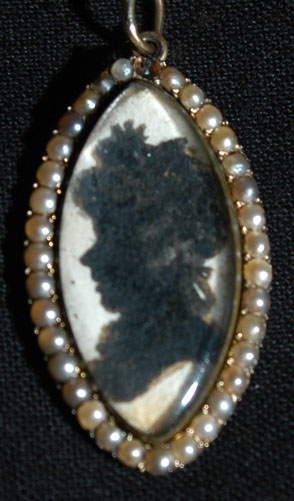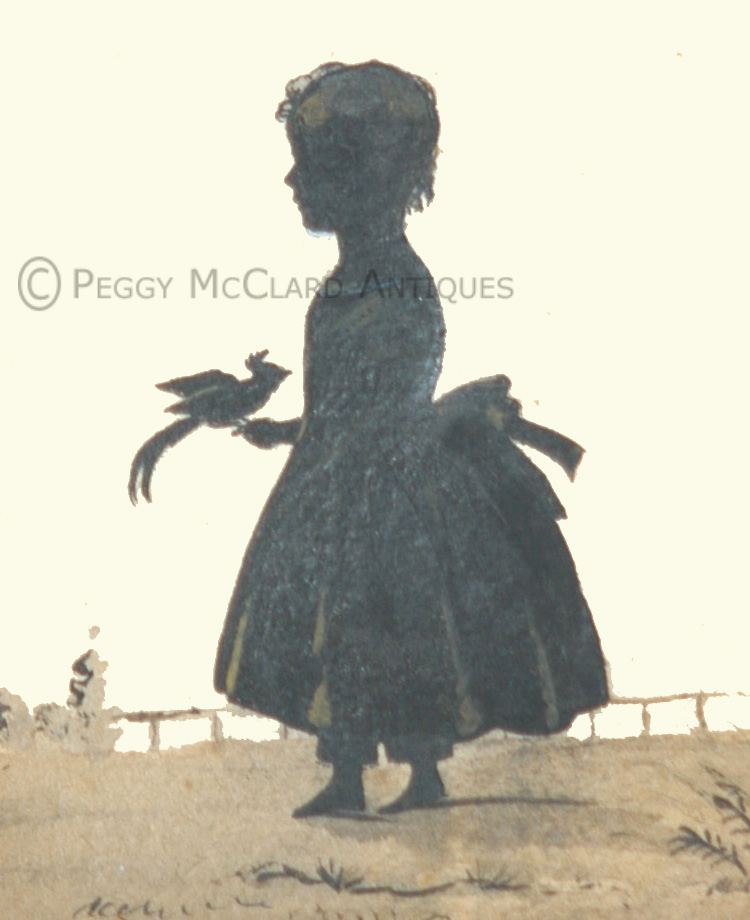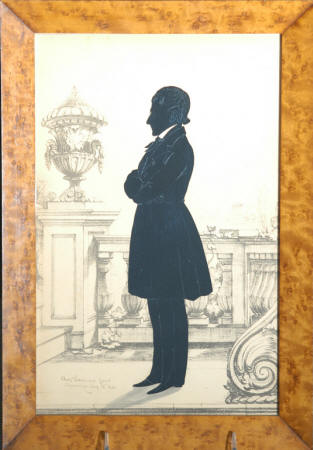Just for Fun
History of Silhouette
Miniature portraits had been the rage of aristocracy whom had worn portraits as jewelry since at least the 15th century. But for 300 years, the expense required for a full color likeness to be commissioned had restricted the availability to the wealthy and kept the ordinary person from acquiring a portable likeness of their loved ones. In the late 18th century, shade portraits became popular with the masses because it represented a cheaper alternative to full color portraits.
Although the black profile was made popular by the masses, its popularity soon reached across income levels back to the aristocracy. Wealthy patrons commissioned silhouettes to be painted and encrusted with precious stones in jewelry and snuff boxes. Royalty commissioned porcelain dinner services with silhouettes. Common folk filled albums with silhouette likenesses of family and friends.
Originally called "Profile Shades" or "Shadows" in England, the French coined the term "à la Silhouette" as a derogatory reference to Louis XV's former French Minister of Finance, Etienne de Silhouette, who was considered a cheapskate. When de Silhouette left his government position, he reputedly retired to a farmhouse which he decorated with home-made paper cuttings. However, by the early 19th century, profile artists began to associate Silhouette with elegance, as illustrated by an advertisement in the Mary 4, 1813 New York Gazette:
E. Metcalf, Miniature and Profile Painter, respectfully informs his friends and the public, that he has removed to 21 Courtlandt street, a few doors from Broadway, where he will paint Miniatures & Profiles for from 3 to 15 dollars, warranted - Also, will take the most perfect Likenesses a la Silhouette in his superior style of elegance, reduced to any size, (or copied) from 25 cents to one dollar. He will furnish Miniature and Profile Frames, Lockets, &c. of any description. Private lessons given in Drawing and the French language. Regular attendance from 9 til 3 o'clock. 1
In the second quarter of the 19th century, the great master cutter Edouart felt that the term "shade" was derogatory to his art and began using the term "silhouettist" to describe himself. The term became popular and carried forward to today.
Antique silhouettes may be found in 4 general forms
- Painted on paper, card, vellum, ivory, silk, or porcelain;
- Painted in reverse on glass;
Hollow cut, usually with the aid of a machine but, very rarely by hand. In this process the figure is cut away from the paper thereby leaving a negative image. The paper outline is then backed with a contrasting color of paper or fabric;
- Cut freehand with scissors or knives and then pasted to a contrasting (usually light-colored) background (cut & paste).
On both sides of the ocean, artists of the 19th century sometimes applied their cut or painted silhouettes on lithograph or watercolor backgrounds which bring even more attention to the regal simplicity of the shade portrait itself.
If you would like to learn more about antique silhouettes and silhouette making in the period of 1760 to 1870, I recommend reading any of the following books. They are all out of print but I will try to good used copies of them for sale at Books. If I don't have a copy I might be able to direct you to a used and rare bookseller with the one you are looking for in inventory.
Alice Van Leer Carrick, Shades Of Our Ancestors (Little, Brown, and Company 1928).
E. Nevill Jackson, Silhouettes A History and Dictionary of Artists (Dover Publications, Inc. 1981) **This book was first published in 1938 under the title Silhouette: Notes and Dictionary.
Sue McKechnie, British Silhouette Artists and their Work 1760-1860 (Philip Wilson Publishers Ltd 1978)
Blume J. Rifken, Silhouettes in America, 1790-1840 A Collectors' Guide (Paradigm Press, Inc. 1987).
Emma Rutherford, Silhouette: The Art of the Shadow (Rizzoli New York 2009).
Additionally, please see the Silhouette Biographies page for information about some of our favorite 18th and 19th century silhouette artists. I always appreciate your emails with questions or discussions.
Peggy is available for lectures about antique silhouettes.
1 Many thanks to Sue Anderson for uncovering the 1813 newspaper advertisement that has enlightened the silhouette world that a la Silhouette was used as a term of elegance by the early 19th century.






